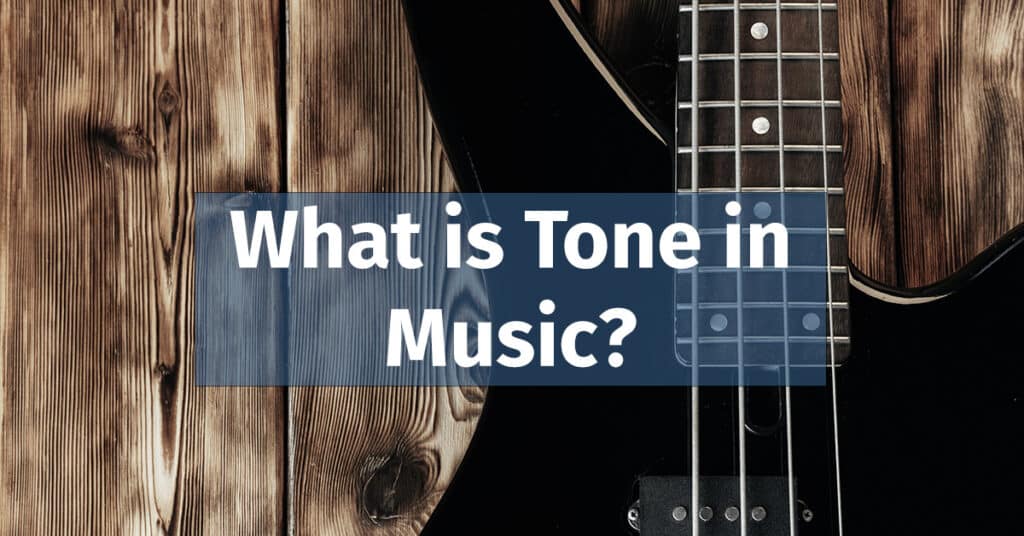A chord in music is a harmonic set of three or more notes played simultaneously, creating the backbone of a song’s harmonic structure.
Introduction
Let’s dive into music theory, beginning with the basic unit that brings harmony and richness to the music we hear — the chord.
So, what is a chord in music? A chord, in its simplest definition, is a group of notes played simultaneously. The harmonious union of individual sounds creates depth and emotional context within a piece of music. However, it’s crucial to understand that not all collections of notes form chords. Specific rules and structures apply, which we will unpack as we delve deeper into this fascinating subject.
We can’t discuss chords without bringing up their components — notes. A note represents a single musical sound. If we consider music a language, consider notes as the alphabet and chords as words.
Chords get their names based on the root note (the primary note upon which a chord is built) and the type of intervals (the distance between two notes) they consist of. The most basic types of chords, such as major and minor, are differentiated by the arrangement of these intervals.
For example, let’s take a “C Major” chord. Here, “C” is the root note, and “Major” implies the structure of the chord, indicating that it’s built with a major third and a perfect fifth above the root.
Don’t worry if some of these terms sound unfamiliar right now. As we move forward, these concepts will become clear. So, get ready to decode the magic behind the melodies you love!
Building Blocks of a Chord in Music
As we delve into chords, we view notes as our primary building blocks. In its most basic definition, a note is a single musical sound. We create a chord by combining multiple notes and playing them simultaneously.
In music theory, there’s an ongoing discussion about the minimum number of notes required to form a chord. Some assert that a chord can be composed of only two notes, a structure often called an “interval” or “dyad.”
One well-known dyad type is the “power chord,” frequently used in rock music and its various sub-genres.
Predominantly played on electric guitars with distortion effects, a power chord comprises the root note and the fifth.
These notes often resonate across multiple strings to provide a powerful and robust sound, with distortion adding sustain and additional harmonic content. For instance, a G power chord (notated as G5) would be composed of G and D.
Though most commonly associated with electric guitars, this potent combination of root and fifth notes can generate a strong sound on any instrument capable of playing chords and be utilized in various musical contexts.
However, many music theorists uphold that a “true” chord comprises at least three distinct notes. This three-note structure is known as a “triad.”
Despite the debate surrounding two-note chords, understanding and mastering triads is widely recognized as a crucial first step in any exploration of chords.
While dyads like power chords have their place in certain genres and contexts, the richness and complexity of triads open up a far wider array of harmonic possibilities.
The Fundamental: The Triad
The most basic and ubiquitous form of a chord is the triad. Some refer to it as the “1 3 5” structure, a reference to the scale degrees of the notes that constitute the chord. To form a triad, we take a given musical scale’s first (root), third, and fifth notes.
Let’s consider an example using the C Major scale. The C Major triad would include the notes C (the “1” or root), E (the “3” or third), and G (the “5” or fifth).
This triad is the simplest form of the chord and serves as a foundation for understanding more complex chord structures. It is these triads that give the melody its structure and harmony.
Understanding the triad is a significant first step in exploring chords. From here, we’ll examine the different types of triads and how altering a note can completely change the chord’s sound and character.
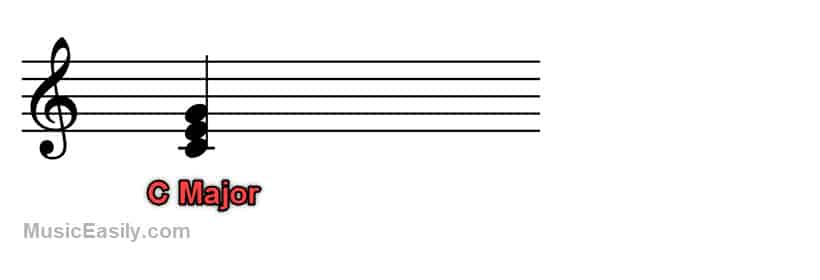
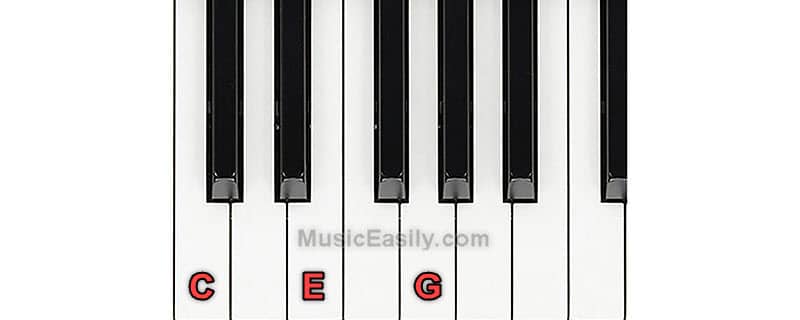
Main Types of Chords: An Overview
Before venturing into the diverse landscape of chords, it’s essential to have a firm grasp on intervals and accidentals. If these concepts need clarification, we recommend diving into our detailed guides on intervals and accidentals before proceeding further into this section.
In Western music, we primarily encounter major, minor, diminished, and augmented chords. We’ll also explore 7th chords to widen our understanding of this multifaceted musical component.
Major and Minor Chords: The Basics
The major and minor chords are the most commonly used in Western music. These are triads, meaning they consist of three notes. These triads are constructed by selecting a root note from a given scale, then stacking two thirds above it.
For a major chord, a major third and then a minor third are stacked on top of the root note. Conversely, for a minor chord, a minor third followed by a major third are stacked above the root.
All three notes, the root and the two thirds, are integral to forming the chord and determining its major or minor quality.
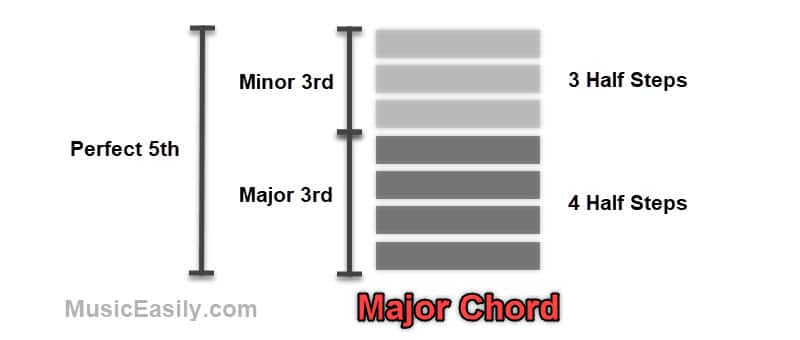
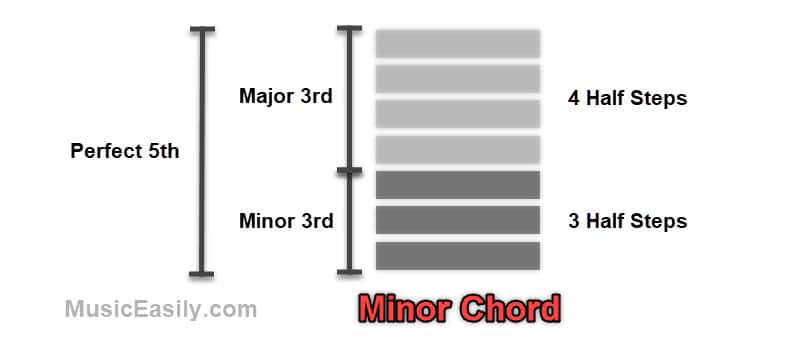
This specific configuration results in the root, a third, and a perfect fifth. It’s important to note that the fifth is always a perfect fifth (seven half-steps) above the root in both standard major and minor chords.
For example, consider a C Major chord consisting of the notes C, E, and G. The interval from C to E is a major third, while the interval from E to G is a minor third, forming a perfect fifth from the root note C. Both these intervals together form a C Major chord.

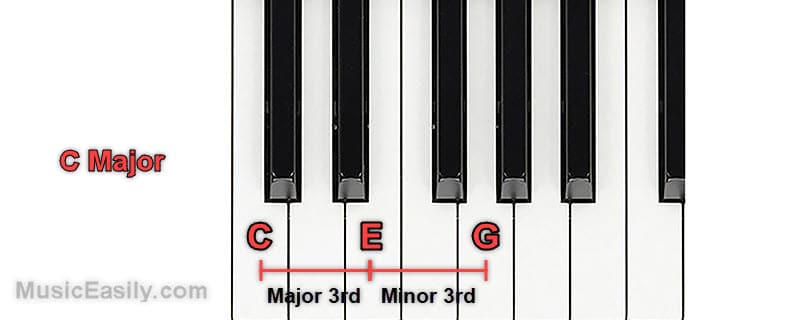
If we lower the E to an E-flat, we now have a C Minor chord: C, E-flat, and G. Here, E-flat is a minor third above C, but G remains a perfect fifth above C.
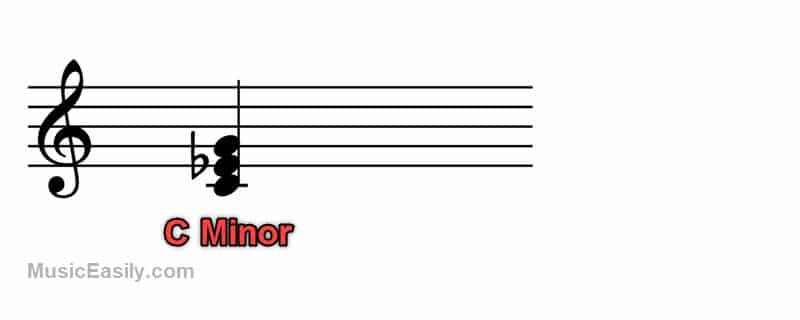
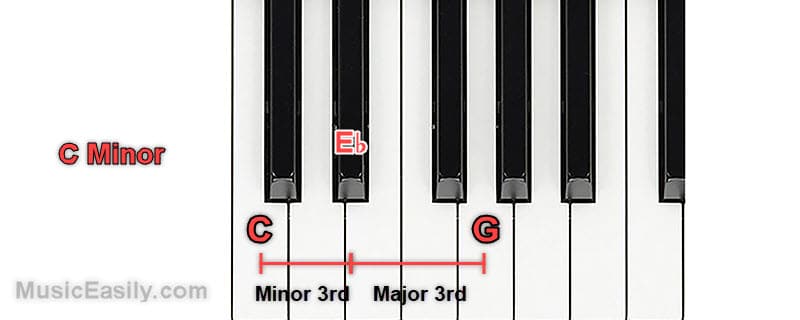
This understanding of chords as stacks of thirds is fundamental to Western music theory, and it provides a deeper understanding of how chords are constructed, which can be useful for improvisation, composition, and advanced harmonic analysis.
Exploring Augmented and Diminished Chords
While augmented and diminished chords are used less frequently than their major and minor counterparts, they bring unique sonic qualities to a piece of music.
Augmented chords are constructed by stacking a major third, followed by another major third. This means an augmented chord has a major third and an augmented fifth – this fifth is one half-step higher than a perfect fifth above the root.
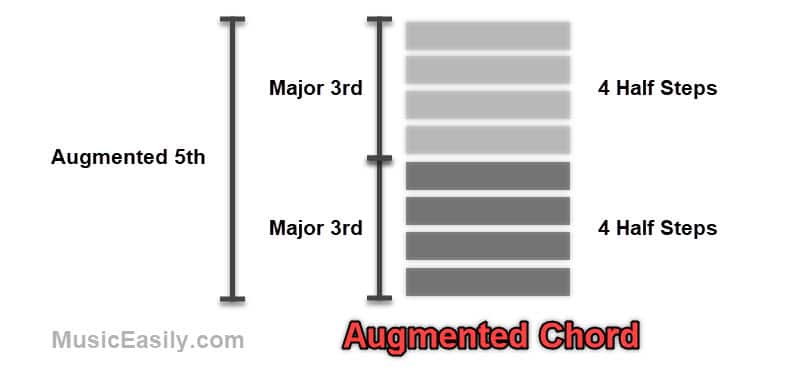
An example of this is a C Augmented chord, composed of the notes C, E, and G-sharp. Augmented chords create a unique tension in the musical context, providing a distinctive harmonic color.
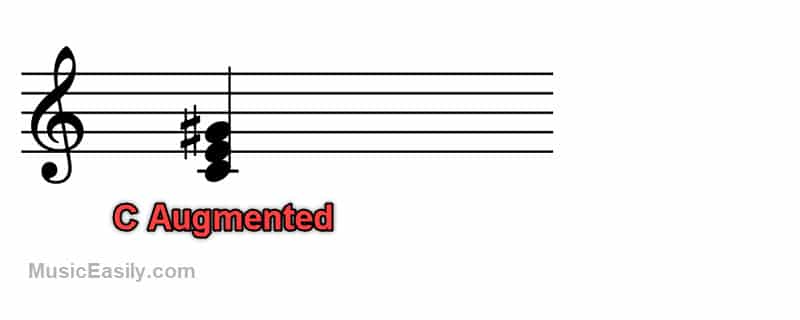
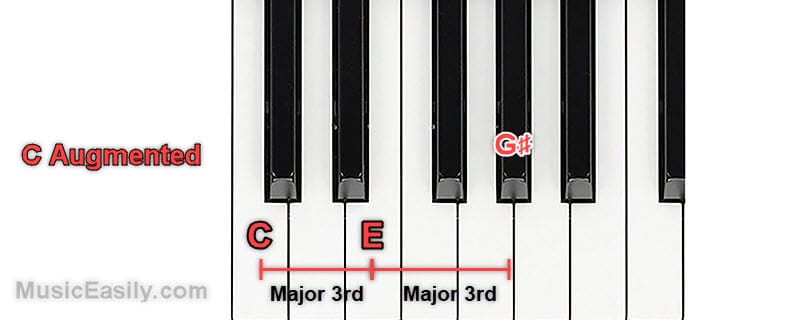
Following augmented chords, we have diminished chords. A diminished chord is a triad built by stacking a minor third and another minor third. In other words, a diminished chord has a minor third and a diminished fifth – this fifth is one half-step lower than a perfect fifth above the root.
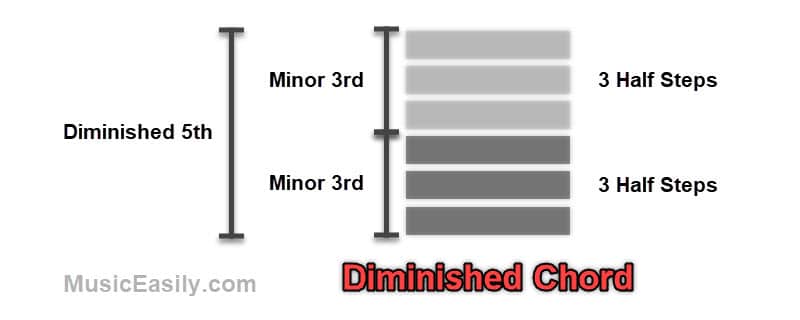
Take, for instance, a C Diminished chord comprising the notes C, E-flat, and G-flat. Much like augmented chords, diminished chords also convey a sense of tension or instability, effectively driving a piece of music toward resolution on a more stable chord.
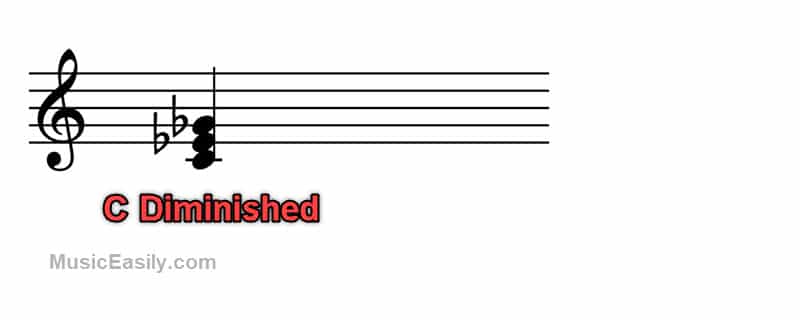
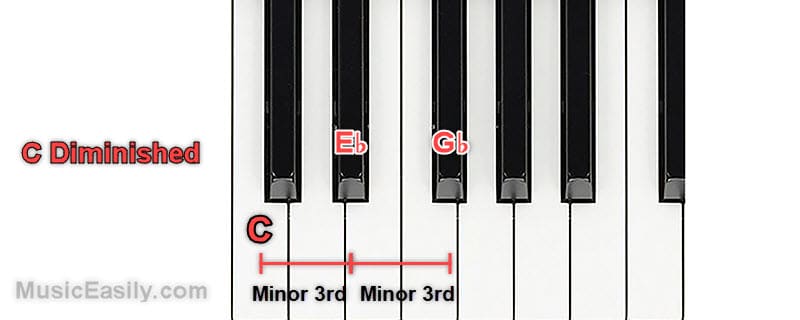
And what about the “devil’s chord“? Despite its use of the word “chord,” this term refers to a specific interval, the tritone, or diminished fifth.
Historically, Western music often avoided this interval due to its dissonant and unsettling sound. However, it’s embraced in modern music for its unique tension and distinctive tonal color.
It’s worth noting that despite the name, it isn’t a chord in the conventional sense but rather a two-note interval with a distinctive sonic character.
This tritone interval is essential in certain chords, such as diminished and dominant 7th chords, creating a strong dissonance between the chord’s third and seventh. This dissonance builds tension that often resolves in the context of chord progressions, contributing to the dynamic flow of the music.
The Journey into Extended Chords: Starting with the 7th
As we delve deeper into the realm of harmony, we encounter extended chords. While the basic major, minor, diminished, and augmented chords are all triads comprising three notes, extended chords offer more intricate structures.
They add further notes beyond the basic triad, introducing extra layers of complexity, richness, and subtlety to the harmonic soundscape.
Extended chords derive their name from adding extra notes, known as “extensions.” These additional notes are stacked as thirds above the notes of the basic triad, extending our familiar root, third, and fifth configuration.
For instance, the note that forms a seventh is a third above the fifth, while the note creating a ninth is a third above the seventh, and so on.
The additional notes contribute to the chord’s overall texture, imbuing it with greater depth and nuanced tonal color. These chords can provide a more complex and sophisticated feel, transforming the mood of a piece or adding interest to a melody.
Let’s start our exploration with the most commonly used extended chord: the seventh chord. Seventh chords are so named because they include the seventh note of the scale in addition to the root, third, and fifth.
Even though extended chords may appear complex at first glance, they are within the reach of beginners. When starting out, one approach to tackling these chords is to play their simplified versions.
You can achieve this by focusing on the basic triad within these extended chords. While this reduces the chord to its essential elements, it still produces a pleasing sound.
It may have a different richness or completeness than the full extended chord, but it provides a solid starting point for beginners wanting to explore more intricate chord structures.
Notably, due to their widespread use across genres, some musicians regard seventh chords as a foundational element rather than an extended chord. This makes them a worthwhile addition to even a beginner’s repertoire.
Among the different types of seventh chords, the major, minor, and dominant seventh are the most common and essential to learn.
Consider the Major 7th chord. A major seventh interval is added to a major triad in this case.
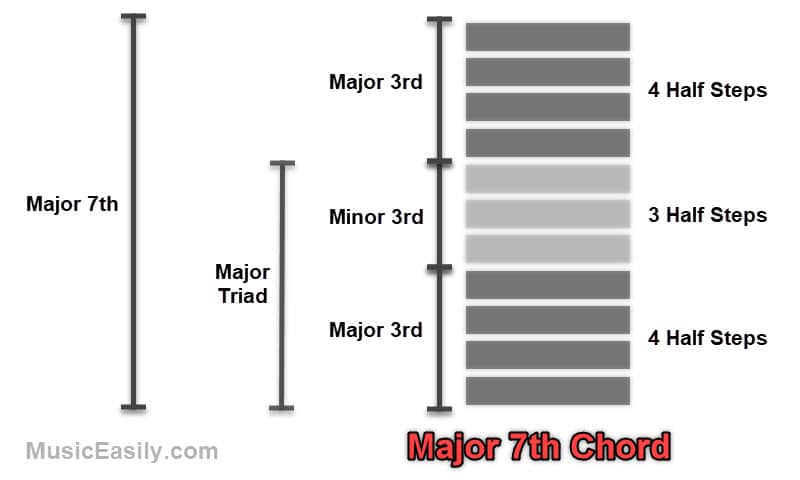
For instance, a C Major 7th chord would consist of the notes C, E, G, and B. The B is a major seventh above the root note, C.
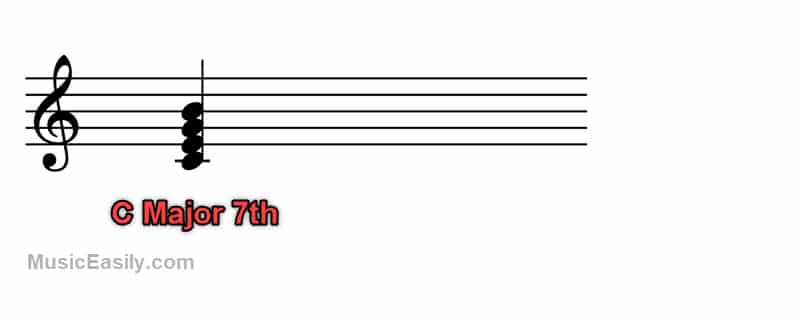

In contrast, a Minor 7th chord is formed by adding a minor seventh interval to a minor triad.
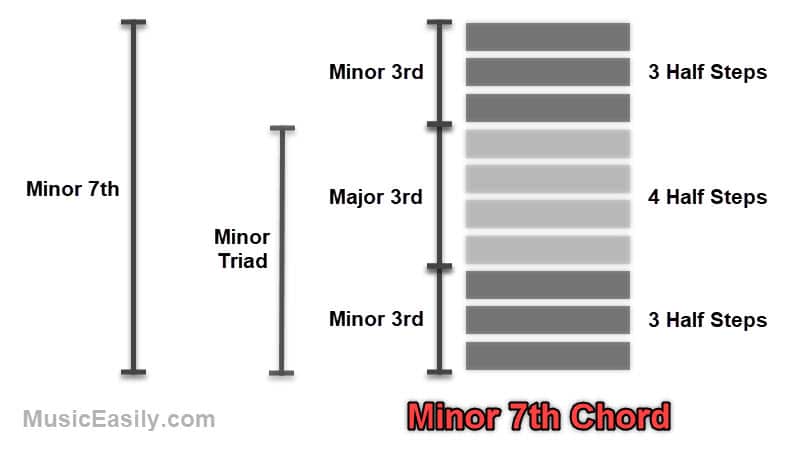
For example, a C Minor 7th chord includes the notes C, E-flat, G, and B-flat. Here, the B-flat is a minor seventh above the root note, C.
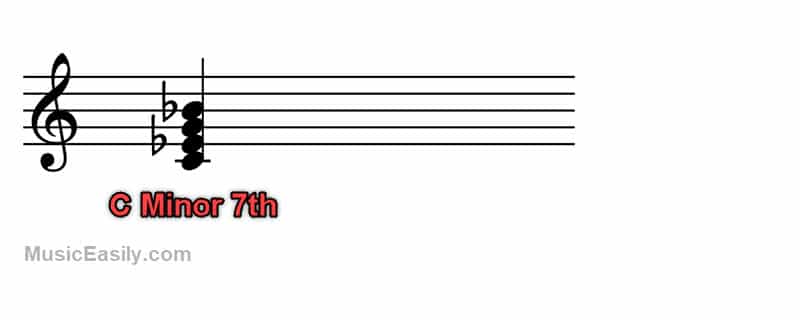
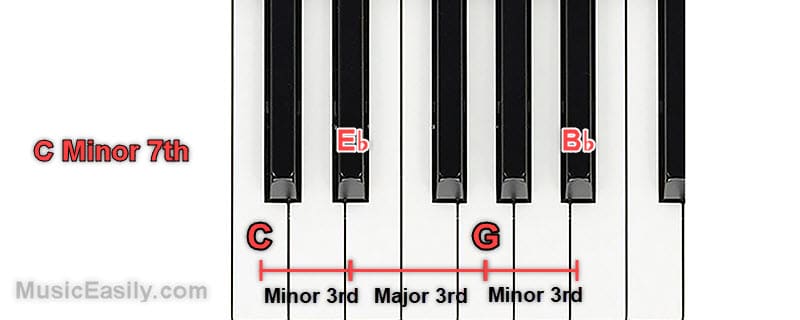
Dominant 7th chords, often called “seventh” chords, are a pivotal and frequently utilized type of chord. They are formed by adding a minor seventh interval to a major triad.
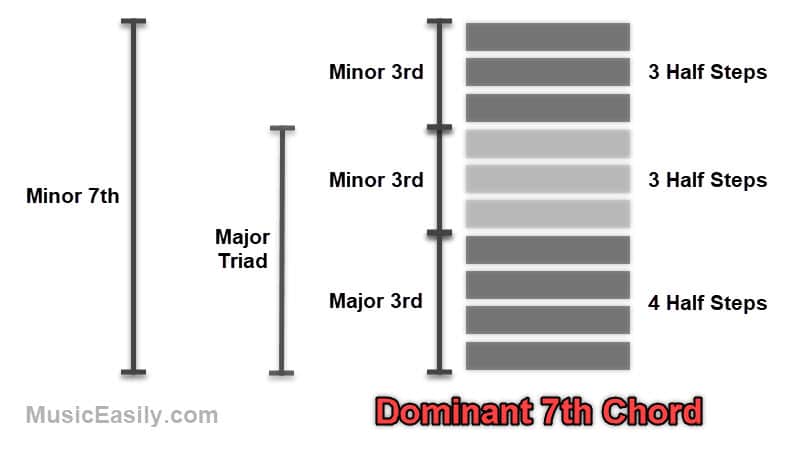
For example, a C Dominant 7th chord would consist of C, E, G, and B-flat.
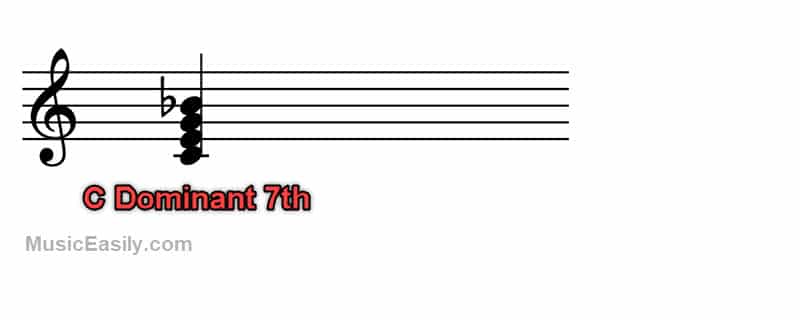
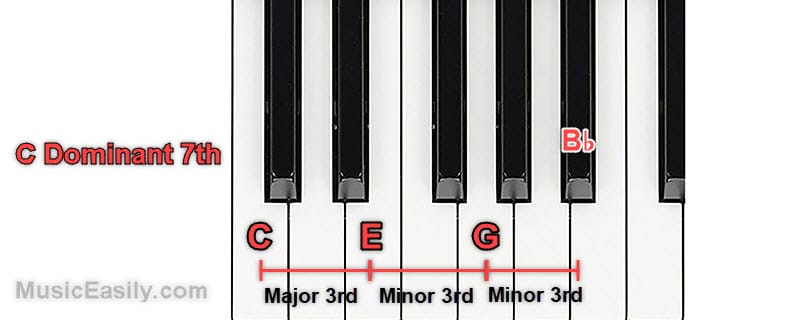
This structure creates a blend of major and minor qualities, introducing heightened tension to the music. The name “dominant” arises because these chords are typically built on a major scale’s fifth (dominant) note.
These are just a few examples of the many types of seventh chords used in Western music. Each of these chords carries its unique emotional tone and can significantly impact the mood and progression of a piece of music. Understanding seventh chords and beyond is fundamental to delving deeper into the complexities of music composition and harmony.
Beyond the Basics
Having grasped the basic major, minor, and seventh chords, you’re now prepared to venture further into the fascinating world of chord theory. This section won’t delve into the complexities but will spotlight key areas to explore as you advance your chord knowledge and skills.
An intriguing concept to investigate next is the idea of ninth, eleventh, and thirteenth chords. These extended chords add further notes to seventh chords, usually in intervals of thirds. These additional notes extend beyond the octave.
For example, a C major ninth chord comprises the notes C, E, G, B, and D, with the D being the ninth note in the C major scale.
Extended chords enrich the complexity and color of music, finding prominence in various genres, including jazz, pop, rock, and more. By incorporating extended chords into your repertoire, you can introduce a richer, more nuanced sound to your compositions.
A further concept worth your attention is chord alterations. This entails manipulating notes in a chord – they can be raised, lowered, or added. Such manipulation gives birth to a unique set of variants known as altered chords.
Consider the G7 chord (G, B, D, F). You could adjust the fifth note (D) to a sharp fifth (D#) or a flat fifth (Db), resulting in G7#5 or G7b5, respectively. Another possibility includes adding a ninth to a triad while leaving out the seventh. This would result in a chord like Cm(add9), which implies a C minor triad with an added ninth.
Altered chords introduce an additional layer of tension and complexity, making them a key feature in genres like jazz and blues.
Adding to your chord knowledge, let’s briefly examine suspended chords. They displace the traditional major third note of a major triad with a perfect fourth, creating a distinctive sound.
For example, a C suspended chord (“C sus4”) comprises the notes C, F, and G, introducing an unexpected tension that often resolves to a familiar major chord, like C Major (C, E, G).
Last but not least, understanding chord inversions is beneficial. An inversion happens when a note other than the root becomes the lowest note in the chord. Inversions can rejuvenate familiar chords, enabling smoother transitions and more captivating harmonic progressions.
As you continue this journey, remember that these advanced concepts build on the fundamentals. Keep revisiting and strengthening your understanding of basic chords.
Also, explore how these chords fit into key signatures and deepen your understanding of the diatonic chords that shape the framework of our songs.
A deeper dive into diatonic chords and their influence on song tonality will aid your exploration of more complex chord structures.
Which Ones to Learn First
Starting your journey into chords might seem daunting, given the sheer number of chords. However, it’s essential to note that all chords stem from a few fundamental types. Understanding these types and which chords to learn first can create a strong foundation for your musical growth.
For beginners, starting with the major and minor chords is recommended. These are the most commonly used chords in Western music, from pop and rock to classical and jazz. They form the backbone of countless memorable songs and are often the first port of call for any new musician.
Start by learning the major and minor chords for all the chromatic scale notes. You can learn these chords on any instrument, but a keyboard might be more intuitive due to its visual layout.
Once you’re comfortable with the major and minor chords, you can expand your chord vocabulary to include seventh chords, like the dominant seventh, major seventh, and minor seventh. These chords add an extra layer of complexity and are a staple in genres like blues and jazz.
When learning chords, the best approach is hands-on practice. Start by familiarizing yourself with how each chord looks and sounds.
You can do this by playing the chords on your instrument or using a chord chart. Next, practice transitioning smoothly between different chords. This will enhance your skill and make it easier for you to play songs.
As you become more comfortable with these chords, apply them to simple songs. This will help you see how chords fit together in a musical context. Over time, you’ll build a strong chord vocabulary and develop an intuitive understanding of how chords function within music.
Remember that learning chords is a gradual process, so don’t rush. Practice consistently, and before you know it, you’ll have a solid grasp of the fundamental chords.
Conclusion
In the world of music, understanding chords is a rewarding journey.
From the fundamentals of major and minor chords to the more advanced territories of extended and altered chords, every step enhances your musical palette, allowing you to paint increasingly expressive and intricate musical landscapes.
Remember, it’s not about the number of chords you learn but your proficiency and application in using them. Begin with the basics, then gradually explore more complex chords. Your music benefits as your chord vocabulary expands.
The more you use chords—whether writing a song, improvising, or just noodling around—the more familiar they’ll become. You’ll start to recognize common patterns and develop an instinct for which chords sound good together.
Refrain from being daunted by the extensive realm of chords. Each new chord you learn is another string to your bow, a new way to express your musical ideas.
Be patient and enjoy the process, for the world of chords is vast but endlessly fascinating and creatively fulfilling. Embrace the journey, and let the world of chords spark your musical expression.
As you continue to deepen your chord knowledge and embark on more intricate compositions, you may find it rewarding to explore the complex and captivating world of jazz chords (ext. link), which offer a unique blend of harmonic richness and tension.


